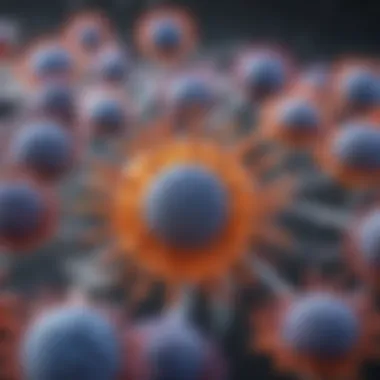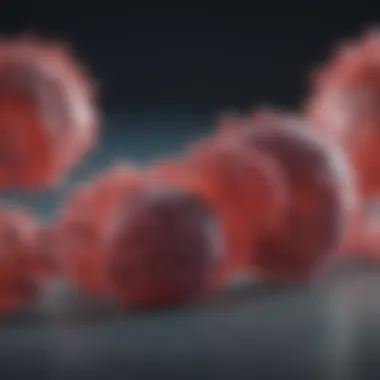Exploring the Benefits of Immune Checkpoint Inhibitors


Intro
The realm of cancer treatment has evolved substantially over the past few decades. Traditional therapies often focus on direct attack mechanisms against tumors, yet they may lack specificity and lead to significant side effects. Immune checkpoint inhibitors represent a transformative approach in oncology. They harness the body's own immune system to identify and destroy cancer cells effectively. This article endeavors to elucidate the benefits of these innovative therapies, their underlying mechanisms, and the latest advancements in research.
Key Concepts
Definition of the Main Idea
Immune checkpoint inhibitors function by blocking specific proteins on immune cells or cancer cells that inhibit immune response. By doing so, these drugs enhance the ability of T-cells to fight cancer. This revolutionary approach not only improves survival rates but also aims to reduce the recurrence of cancer post-treatment.
Overview of Scientific Principles
The effectiveness of immune checkpoint inhibitors relies on understanding immune checkpoints like PD-1, PD-L1, and CTLA-4. When activated, these checkpoints can prevent T-cells from attacking cancer cells. Inhibitors such as Pembrolizumab and Nivolumab target PD-1 protein, while Ipilimumab targets CTLA-4. This blockage fosters a more profound immune response against malignancies.
- Mechanisms of Action:
- Advantages Over Traditional Therapies:
- PD-1/PD-L1 pathway inhibition
- CTLA-4 blockade
- Activation of cytotoxic T lymphocytes
- Enhanced specificity in targeting cancer cells
- Improved long-term survival outcomes
- Potential for durable responses
Current Research Trends
Recent Studies and Findings
Recent studies have shown promising results in various cancer types, including melanoma, lung cancer, and renal cell carcinoma. Clinical trials are ongoing, assessing the efficacy of combination therapies that utilize immune checkpoint inhibitors along with traditional chemotherapy or radiation. These integrative approaches aim to broaden the therapeutic window and enhance patient outcomes.
Significant Breakthroughs in the Field
Innovations in this field also include the exploration of biomarkers that predict patient response to therapy. Biomarkers such as tumor mutational burden (TMB) and microsatellite instability (MSI) are showing potential in personalizing treatment plans. Moreover, the development of novel checkpoint inhibitors is continuously under investigation, expanding the arsenal available to oncologists.
"Understanding the patient’s unique tumor microenvironment is crucial when designing effective treatment strategies with immune checkpoint inhibitors."
"Understanding the patient’s unique tumor microenvironment is crucial when designing effective treatment strategies with immune checkpoint inhibitors."
Overall, the landscape of cancer treatment is shifting towards these advanced modalities. As research advances, the scope of immune checkpoint inhibitors may broaden, providing new hope for patients worldwide.
Further details can be examined through reliable sources such as Wikipedia and Britannica.
Prelims to Immune Checkpoint Inhibitors
The exploration of immune checkpoint inhibitors represents a significant advancement in cancer therapy. These agents modify the immune response to enhance its ability to combat cancer cells. They have revolutionized treatment, providing options where traditional methods have often fallen short. Understanding immune checkpoint inhibitors is essential for comprehending modern oncology.
Defining Immune Checkpoint Inhibitors
Immune checkpoint inhibitors are drugs that release the brakes on the immune system. Normally, the body has mechanisms to prevent overactive immune responses, which can damage healthy tissue. Immune checkpoints are part of these regulatory pathways. Key proteins, such as PD-1, PD-L1, and CTLA-4, play pivotal roles in this inhibition. By blocking these proteins, checkpoint inhibitors allow T-cells to attack cancer cells more effectively. The importance of these agents is underscored by their capability to convert previously untreatable cancers into manageable conditions.
History and Development
The journey of immune checkpoint inhibitors began in the late 20th century, with foundational research focusing on the immune system's ability to recognize and destroy tumors. Key breakthroughs occurred with the discovery of CTLA-4 in 1996 by James Allison. He demonstrated that blocking CTLA-4 could enhance immune response against tumors.
This led to the development of ipilimumab, the first checkpoint inhibitor approved for melanoma in 2011. Subsequently, the field expanded, and agents targeting PD-1 and PD-L1 gained prominence, with pembrolizumab and nivolumab emerging as leading treatments.
The evolution of these therapies showcases not only a better understanding of the immune landscape but also a commitment to improving patient outcomes. Today, immune checkpoint inhibitors are essential components in the treatment of diverse cancers, from melanoma to lung cancer, illustrating their growing significance in the oncology arsenal.
Mechanisms of Action
Understanding the mechanisms of action of immune checkpoint inhibitors is crucial for grasping their efficacy in cancer treatment. These treatments fundamentally alter immune responses, enabling the body to identify and combat cancer cells more effectively. By focusing on specific immunological pathways, these agents help in highlighting unrecognized aspects of the immune system’s functionality. The ability to harness the immune system means potentially developing lasting immunity against tumors that can significantly improve patients' outcomes.
Immune Response Modulation


Immune response modulation is a central concept related to immune checkpoint inhibitors. These therapies enhance the immune system's ability to respond to tumors by adjusting how immune cells function. For instance, T-cells play a vital role in recognizing cancer cells. When these T-cells encounter checkpoint proteins, their activity may be inhibited, preventing a robust immune response. Immune checkpoint inhibitors, such as pembrolizumab and nivolumab, target these proteins, removing the brakes on the immune system. As a result, T-cells can attack and destroy tumor cells more effectively.
- Importance of T-cells: T-cells are essential for tumor elimination. They detect specific antigens presented on cancer cells. By enhancing T-cell activation, immune checkpoint inhibitors improve the chances of successful tumor rejection.
- Impact on Tumor Microenvironment: These agents also modify the tumor microenvironment. They can increase the amount of infiltrating immune cells, fostering a location conducive to immune-mediated tumor destruction. This change can lead to a systemic anti-tumor response.
Moreover, the modulation of the immune response addresses the challenge of tumor heterogeneity. Tumors can be diverse, with varying antigens, making a uniform immune approach ineffective. Immune checkpoint inhibitors can help in generating a more dynamic immune response, allowing the immune system to adapt over time as the tumor evolves.
Blocking Checkpoint Proteins
Blocking checkpoint proteins is a pivotal mechanism by which immune checkpoint inhibitors exert their therapeutic effects. Proteins such as PD-1 and CTLA-4 are critical checkpoints that cancer cells exploit to evade immune detection. By inhibiting these proteins, immune checkpoint inhibitors boost the immune system's ability to recognize and attack cancer cells.
- PD-1 Pathway: Programmed cell death protein 1 works by binding to its ligands, PD-L1 and PD-L2, typically expressed on tumor cells. When activated, PD-1 sends inhibitory signals to T-cells, effectively dampening their activity. By blocking PD-1, drugs like pembrolizumab disrupt this signaling and revive T-cell function, thus promoting tumor cell destruction.
- CTLA-4 Mechanism: Similarly, cytotoxic T-lymphocyte-associated protein 4 (CTLA-4) limits T-cell activation. Drugs like ipilimumab inhibit CTLA-4, enhancing immune activation during the initial stages of T-cell response. This step is crucial for generating a robust immune attack against tumors.
Immune checkpoint inhibitors represent a paradigm shift in cancer therapy by precisely targeting regulatory pathways that govern immune responses.
Immune checkpoint inhibitors represent a paradigm shift in cancer therapy by precisely targeting regulatory pathways that govern immune responses.
Benefits of Immune Checkpoint Inhibitors
Immune checkpoint inhibitors represent a transformative approach in cancer therapy, fostering new strategies to combat malignancies. These agents primarily work by stimulating the immune system to recognize and attack cancer cells, leading to substantial therapeutic benefits. In this section, we will explore specific advantages offered by these therapies, focusing on increased survival rates, durable responses, and their applicability across diverse tumor types.
Increased Survival Rates
One of the most significant benefits of immune checkpoint inhibitors is their impact on patient survival rates. Numerous clinical trials and studies have demonstrated that these therapies can lead to extended survival in various cancer types, particularly melanoma, non-small cell lung cancer, and renal cell carcinoma. This is a vital consideration as traditional treatments, such as chemotherapy, often lack this level of efficacy across different patient populations.
Recent data indicates that patients treated with agents such as Pembrolizumab or Nivolumab have experienced improved overall survival compared to those receiving standard-of-care regimens. In some cases, long-term survival rates have doubled, representing a meaningful advancement in oncologic outcomes. Importantly, the survival benefits of these medications are not confined to highly specific genetic markers, increasing their relevance in a broader patient demographic.
Durable Responses
Another compelling advantage of immune checkpoint inhibitors is the potential for durable responses. Unlike traditional treatments that may shrink tumors temporarily, these inhibitors frequently induce sustained remission. The mechanisms of action enable the immune system to retain a memory of tumor antigens, allowing for continued attack on cancer cells even after therapy ends.
According to key studies, some patients have shown years of remission following a finite course of treatment. This long-lasting response is profound, particularly for cancers known for their aggressive nature. Such durable effects contribute not just to improved survival but also to enhancing the quality of life for many patients.
Broad Applicability Across Tumor Types
The broad applicability of immune checkpoint inhibitors is another notable benefit. While historically cancer treatments have been narrowly tailored, checkpoint inhibitors show effectiveness across various tumor types. For instance, agents such as Atezolizumab have been approved for cancers including bladder cancer, triple-negative breast cancer, and hepatocellular carcinoma, among others.
The versatility of these treatments reflects a paradigm shift in oncology that enables oncologists to consider immunotherapy as a frontline approach. Furthermore, the exploration of their use in earlier-stage cancers and in combination with other therapies is expanding, potentially changing the landscape of cancer treatment further.
"Immune checkpoint inhibitors are not just a new chapter; they might represent a completely new book in cancer therapy."
"Immune checkpoint inhibitors are not just a new chapter; they might represent a completely new book in cancer therapy."
In summary, the benefits of immune checkpoint inhibitors are substantial. Increased survival rates, the prospect of durable responses, and wide applicability make them a cornerstone in contemporary cancer treatment. As ongoing research continues to expand our understanding, these medications may offer even greater promise for patients in the future.
Comparative Analysis with Traditional Therapies
Understanding immune checkpoint inhibitors requires examining their advantages compared to traditional cancer therapies. Traditional therapies, such as chemotherapy and radiation, follow a more conventional approach of directly targeting and destroying rapidly dividing cancer cells. Immune checkpoint inhibitors, however, utilize the body’s immune system, enhancing its ability to detect and attack tumors.
This comparative analysis reveals crucial elements including efficacy, side effects, and overall patient experience. It allows researchers and healthcare professionals to make informed decisions regarding treatment options. The potential shift in practice patterns, clinical guidelines, and patient selection practices underscore the importance of comparing these therapeutic strategies.
Chemotherapy Versus Immunotherapy
Chemotherapy is often the standard treatment for many types of cancer. It employs cytotoxic drugs to kill dividing cells, irrespective of whether they are cancerous or healthy. This strategy can lead to significant side effects due to collateral damage to non-target cells, creating a challenging experience for patients.
In contrast, immunotherapy operates by blocking checkpoint proteins, reinstating the immune system’s ability to fight cancer.
Key differences include:
- Mechanism of action: Chemotherapy works by inducing DNA damage, while immunotherapy enhances immune responses against tumors.
- Side Effects: Chemotherapy is associated with side effects like nausea, hair loss, and immune suppression. Immunotherapy can cause autoimmune responses, though these may be more manageable in some cases.
- Efficacy: Some patients respond poorly to chemotherapy, yet certain cancers show remarkable responses to immune checkpoint inhibitors. For instance, melanoma and lung cancer often benefit more from immunotherapy.


"Immunotherapy marks a paradigm shift in cancer treatment, aiming at a personalized approach rather than a one-size-fits-all strategy."
"Immunotherapy marks a paradigm shift in cancer treatment, aiming at a personalized approach rather than a one-size-fits-all strategy."
Targeted Therapies Comparison
Targeted therapies are designed to attack specific molecular targets associated with cancer. They are generally less toxic than traditional chemotherapy. When comparing targeted therapies to immune checkpoint inhibitors, notable differences arise.
- Target specificity: Targeted therapeutics hone in on specific mutations or proteins. Immune checkpoint inhibitors do not target mutations but rather enhance overall immune activity against cancer.
- Applications: Targeted therapies are effective for specific cancer types, whereas immune checkpoint inhibitors are being studied across a broader range of cancers. For example, PD-1 inhibitors have shown efficacy not just in melanoma, but also in pancreatic cancer.
- Resistance profiles: Resistance develops differently in these approaches. Targeted therapies may face issues with mutations that evade their action. In contrast, checkpoint inhibitors might promote durable responses even in previously resistant cancers.
The comparative analysis aids in understanding how immune checkpoint inhibitors fit into the complex landscape of cancer therapies, allowing practitioners to tailor treatments based on the individual patient’s profile and cancer characteristics.
Patient Selection and Responsiveness
Understanding the role of patient selection and responsiveness is critical for optimizing the benefits of immune checkpoint inhibitors. As these therapies are not universally effective for all patients or tumor types, the process of identifying suitable candidates can greatly enhance treatment outcomes. Proper selection can lead to higher response rates and improve overall survival, making it an essential topic within this discussion.
Identifying Biomarkers
Biomarkers play a pivotal role in determining which patients are most likely to benefit from immune checkpoint inhibitors. These biological indicators can range from specific genetic mutations to protein expressions found on tumor cells. For instance, the presence of PD-L1, a protein that regulates immune responses, serves as a marker for predicting responsiveness to therapies such as pembrolizumab and nivolumab. By assessing biomarkers, clinicians can stratify patients, ensuring that those with the highest potential for positive outcomes receive the appropriate treatment.
Factors to consider when looking for these biomarkers include:
- Tumor Type: Certain cancers, like melanoma and lung cancer, have shown higher responsiveness to checkpoint inhibitors.
- Genomic Profiling: Techniques such as next-generation sequencing can uncover mutations that may be predictive of treatment efficacy.
- Immune Landscape: Evaluating the tumor microenvironment for immune cell infiltration and activity can provide additional insights.
Factors Influencing Treatment Efficacy
Many variables influence the efficacy of immune checkpoint inhibitors beyond patient selection based on biomarkers. Understanding these factors can help clinicians tailor treatment plans for individuals.
- Tumor Mutational Burden (TMB): Higher TMB often correlates with better responses to immune therapies due to increased neoantigens that can trigger an immune response.
- CD8+ T Cell Infiltration: The presence of these immune cells within the tumor is typically associated with improved clinical outcomes, suggesting a more active immune microenvironment.
- Previous Treatment History: Patients who have not previously undergone extensive treatments may have more intact immune systems, possibly leading to better responses.
- Comorbid Conditions: Underlying health conditions can impact how well a patient tolerates treatment, thus affecting responsiveness and outcomes.
- Pharmacogenomics: Differences in drug metabolism among patients can dictate the effectiveness and tolerability of immune checkpoint inhibitors.
"Identifying the right patients for immune checkpoint therapy can greatly elevate therapeutic outcomes, thus showing the significance of proper biomarker assessment and understanding treatment response factors."
"Identifying the right patients for immune checkpoint therapy can greatly elevate therapeutic outcomes, thus showing the significance of proper biomarker assessment and understanding treatment response factors."
By investing in careful patient selection and evaluating various factors influencing treatment efficacy, healthcare providers can enhance the effectiveness of immune checkpoint inhibitors. This strategic approach not only maximizes therapeutic benefits but also aligns with a patient-centered care model, leading to an overall improved cancer treatment landscape.
Adverse Effects and Management Strategies
Exploring the adverse effects associated with immune checkpoint inhibitors is crucial. These therapies can significantly enhance patients' survival and quality of life, but they also come with potential side effects that require careful management. Understanding these adverse effects is essential for ailment planning and patient education.
Common Side Effects
Immune checkpoint inhibitors interact with the immune system, sometimes leading to unintended reactions. The most frequently reported side effects include:
- Fatigue: Many patients report a feeling of exhaustion that can vary in intensity.
- Skin Rashes: Rashes can appear anywhere on the body and often require close monitoring.
- Diarrhea: Gastrointestinal effects can lead to dehydration if not managed appropriately.
- Endocrinopathies: These are hormonal imbalances that may manifest as conditions like thyroiditis or adrenal insufficiency.
- Pneumonitis: Inflammation of lung tissue can cause serious respiratory problems.
The variety of potential side effects stems from the non-specific activation of the immune system. This specificity is vital for treating cancer but can also lead to the immune system attacking healthy cells. Awareness of these side effects ensures that patients and healthcare providers are prepared for detection and intervention.
Guidelines for Management
Effective management strategies for the side effects of immune checkpoint inhibitors are essential for patient safety and treatment adherence. Here are important considerations and strategies that clinicians should implement:
- Regular Monitoring: Frequent evaluations are necessary to identify adverse effects early. This includes blood tests and assessments of vital signs.
- Patient Education: Informing patients about potential side effects helps them report symptoms promptly. They should understand what symptoms to look for and when to seek medical care.
- Symptomatic Treatment: Management may require specific treatments. For example, corticosteroids are often effective for inflammatory complications.
- Multidisciplinary Approach: Collaboration among oncologists, dermatologists, and endocrinologists, among others, can provide a comprehensive treatment strategy tailored to patient needs.
- Use of Guidelines: The National Comprehensive Cancer Network (NCCN) provides guidelines for managing adverse effects of immunotherapies, which should be consulted regularly.
"Management strategies for immune checkpoint inhibitors play a vital role in ensuring patient quality of life and treatment success."
"Management strategies for immune checkpoint inhibitors play a vital role in ensuring patient quality of life and treatment success."
Recent Advances and Research Frontiers


Recent advances in immunotherapy focusing on immune checkpoint inhibitors are transforming cancer treatment. The rapidly evolving landscape highlights new strategies and innovative approaches that enhance treatment efficacy and patient care. Advances in this field not only underline the potential of immune checkpoint inhibitors but also introduce complex dynamics, such as combination therapies and novel agents under investigation. Understanding these developments is vital as they could significantly alter therapeutic outcomes for numerous cancer types.
Combination Therapies
Combination therapies are emerging as a critical focus in the pursuit of maximizing the effectiveness of immune checkpoint inhibitors. These strategies involve integrating immune checkpoint inhibitors with other modalities, such as chemotherapy, targeted therapies, or radiation. The rationale is straightforward: leveraging the synergistic effects of various treatment methods can produce more potent anti-tumor responses.
Research indicates that combining immune checkpoint inhibitors, like Pembrolizumab, with traditional chemotherapy can improve survival rates in specific cancers, including non-small cell lung cancer and melanoma. Further studies aim at optimizing the timing and sequencing of such combinations to enhance their efficacy.
Additionally, combination therapies not only aim to improve response rates but also to prevent or overcome resistance to single-agent treatments. For instance, patients who do not respond initially to monotherapies may benefit from subsequent treatment with a combination strategy, highlighting the significance of personalized therapy in this context.
"The future of cancer treatment may lie in combining different therapeutic approaches to create a more resilient treatment paradigm."
"The future of cancer treatment may lie in combining different therapeutic approaches to create a more resilient treatment paradigm."
Despite these promising findings, careful patient selection is essential when considering combination therapies. Understanding the tumor microenvironment and individual tumor characteristics is key to delivering effective treatments while minimizing potential adverse effects.
Novel Agents Under Investigation
Parallel to developing combination therapies, researchers are investigating several novel agents that target immune checkpoints. Agents such as Atezolizumab and Nivolumab are already approved, but the pipeline is rich with new candidates aiming to expand options for tailored treatments.
Emerging agents are not limited to the established PD-1 and CTLA-4 targets. Research is exploring different checkpoint proteins like LAG-3 and TIM-3, which could further modulate the immune response. These innovative therapies may allow for broader applicability across various tumor types and could address existing limitations of current treatments.
Also, researchers are exploring biomarkers that can predict responses to new agents. Understanding which patients are likely to benefit from specific treatments will shape future clinical practice.
Future Directions in Immunotherapy
The landscape of immunotherapy is evolving rapidly. Future directions in immunotherapy are vital for maintaining the momentum of innovation in cancer treatment. This section outlines progressive strategies that aim to optimize the efficacy of immune checkpoint inhibitors and expand their reach across various medical fields.
Personalized Treatment Approaches
Personalized treatment approaches are at the forefront of future immunotherapy. The core concept is tailoring therapies to individual patient profiles, which encompasses unique genetic, molecular, and environmental factors influencing tumor behavior. Biomarker discovery has a pivotal role here. By identifying specific markers, clinicians can better match patients with the most effective treatment options. This customization not only enhances treatment efficacy but also minimizes adverse effects.
Recent insights reveal that certain patients exhibit significantly better responses to specific immune checkpoint inhibitors. For instance, patients with high levels of PD-L1 expression on their tumors experience greater benefits from pembrolizumab. Understanding these interactions helps refine patient selection strategies, ultimately leading to improved healthcare outcomes.
Moreover, combining personalized approaches with available data analytics drives the field forward. Advanced algorithms can analyze vast datasets from clinical trials and real-world evidence to establish patterns in treatment success. This analysis can empower clinicians to make informed decisions that align with patients’ unique genetic make-ups.
Expanding Indications Beyond Oncology
Expanding indications beyond oncology represents another promising direction for immunotherapy. While immune checkpoint inhibitors have achieved remarkable successes in treating several cancers, research is exploring their potential applications in other diseases, particularly autoimmunity and infectious diseases.
For example, ongoing studies are investigating the efficacy of these inhibitors in treating conditions like rheumatoid arthritis and multiple sclerosis. In such cases, the goal is to modulate immune responses rather than merely unleashing them, which is essential in managing autoimmune disorders.
A significant aspect of this expansion includes assessing the safety and effectiveness of immune checkpoint inhibitors against various viral infections. Research indicates they could enhance the immune system's ability to combat persistent infections, such as HIV and Hepatitis C. The implications of this could be profound, altering the treatment landscape for many chronic conditions.
Investing in research to explore these avenues could yield advantageous outcomes, potentially changing how we approach treatment in diverse health contexts.
Investing in research to explore these avenues could yield advantageous outcomes, potentially changing how we approach treatment in diverse health contexts.
The End
The conclusion serves as a crucial component in understanding the broader implications of immune checkpoint inhibitors in cancer treatment. It condenses the insights accumulated throughout the article, emphasizing not only the significance of these inhibitors but also their transformative potential within oncology. By reviewing the mechanisms, benefits, and future directions, this section articulates how immune checkpoint inhibitors are reshaping cancer therapies.
Summation of Key Insights
Immune checkpoint inhibitors hold considerable promise, which the article highlights in several key areas:
- Increased survival rates: Many patients experience significantly better outcomes compared to traditional therapies.
- Durable responses: These treatments can provoke long-lasting effects, leading to persistent remission in cancer cases that were once deemed incurable.
- Broad applicability: Their ability to treat various tumor types indicates a wide spectrum of potential benefits.
By presenting these insights, the article underscores the strategic role that these therapies play in modern medicine. The possibilities for enhancing patient quality of life become clear, demonstrating a shift toward more personalized and effective approaches in managing cancer.
Long-term Implications for Cancer Treatment
The long-term implications of integrating immune checkpoint inhibitors into standard treatment protocols are profound. Their introduction alters the traditional treatment landscape.
- Personalized care: Future therapies will likely amplify the movement toward tailormade treatments based on individual patient profiles, including genetic factors and tumor characteristics.
- Policy and economic impact: Manufacturers and healthcare providers must navigate the costs associated with advanced therapies, which could affect insurance coverage and healthcare policies.
- Research and development: Continuous studies and clinical trials will refine treatment protocols, aiming to maximize efficacy while minimizing adverse effects.







